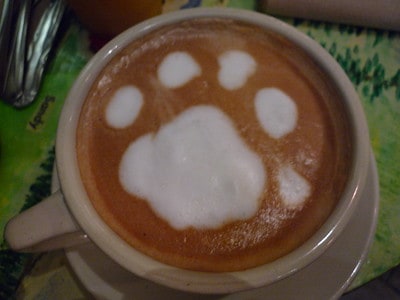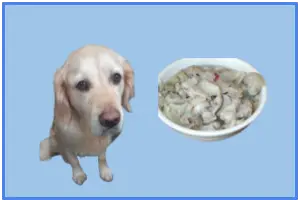
Does your dog follow you around the kitchen?
I know mine does.
Even when I’m not moving, she is there or thereabouts pretending not to look at me.
But she knows that sooner or later a scrap or morsel of food will fall onto the floor.
A scrap of bread as I take the loaf out of its wrapper, or a few stray porridge oats as I carelessly pour them into a saucepan.
Or, and I’m cringing here, stray coffee beans from the bag as I pour them into the grinder.
With the bread and the porridge oats, I don’t bat an eyelid.
But coffee beans? What will happen if my dog ate a coffee bean?
What you will learn in this article
- Are coffee beans toxic to dogs?
- What is caffeine and how does it affect a dog?
- How much caffeine does it take to poison a dog?
- How much caffeine is in a coffee bean?
- Number of coffee beans vs weight of coffee
- What are the side effects of caffeine poisoning in a dog?
- Treatment of dog with caffeine poisoning
- Chocolate covered coffee beans
- Ground beans vs instant coffee vs tea vs Red Bull
Are coffee beans toxic to dogs?
Coffee beans are toxic and can poison your dog, if they consume enough of it.
And the reason for this is that coffee beans contain caffeine which is a stimulant.
The good news is that if your dog only eats only a few coffee beans then it is unlikely that they will become ill.
Later on I use my Golden Retriever as an example.
Using some online calculators, I believe that she can safely eat over 200 coffee beans without placing herself in harm’s way.
Another piece of good news is that although coffee and caffeine are harmful to dogs they aren’t as dangerous as chocolate- or they aren’t as dangerous as some types of chocolate.
What is caffeine and how does it affect a dog?
Caffeine is a class of stimulant called a methylxanthine. A methylxanthine stimulates the body’s nervous system.
Caffeine is the world’s most widely consumed psychoactive drug because it is legal and it’s consumption is unregulated.
How much caffeine does it take to poison a dog?
It is believed that about half of all dogs that die with caffeine poisoning have between 100- 200 mg per kg of caffeine in them.
So, the size and weight of your dog is a very important factor.
If a small dog and a large dog were to eat the same number of coffee beans, the smaller dog would be at a greater risk of poisoning.
This is hard to wrap your head around and so to help you, I’m going to give you an example.
One of my Golden Retrievers, Sylvie, is 30 kg.
Using the chocolate toxicity calculator on this page, and using this page to find the weight of a coffee bean…
I worked out that Sylvie could safely consume around 220 coffee beans before I would need to take her to vets for emergency treatment.
How much caffeine is in a coffee bean?
Measuring the amount of caffeine in a coffee bean isn’t an exact science because there are two varieties of coffee beans- Arabica and Robusta.
It is a bit like trying to answer the question “how much sugar is there in a cookie?”
But we do know the average amount of caffeine that is in an Arabica bean and a Robusta coffee bean.
A roasted Arabica bean contains about 6 mg of caffeine, whereas a Robusta bean contains about 10 mg.
Does the roast level matter?
If you are a keen coffee lover, you might have heard that the amount of caffeine in a coffee bean or within ground coffee depends on its level of roast.
Traditionally, there are three different “roast” levels: light, medium and dark.
Obviously, dark beans have been roasted longer than light or medium roast beans.
There is a strongly held belief in the coffee world that dark roasted beans have more caffeine in them than light or medium roasted beans.
This is a myth.
Regardless of the level of roasting, each coffee bean has approximately the same amount of caffeine.
Number of coffee beans vs weight of coffee
As a dog owner who is only concerned by the number of coffee beans that your dog ate, the roast level will make no difference.
But, in another way, the roast level can make a big difference.
If you worried about your dog consuming a certain weight of coffee beans, then roast level does matter.
Coffee beans may all have the same caffeine content but there are more dark roast coffee beans in a 50 g scoop than there are medium or light roasted beans.
And in this regard, more beans means more caffeine.
What are the side effects of caffeine poisoning in a dog?
Now, the toxicity calculator that I linked to a short while ago is very helpful because, depending on the amount of coffee beans that your dog has ingested, it will indicate if “no treatment is necessary” or if “emergency treatment is needed”.
But some of you might want some more detail- after all, some dogs might display symptoms of a milder level of poisoning below those levels.
So, what are the symptoms of caffeine poisoning?
We are all familiar with the phrase “wired” to describe a person who has drank too much coffee.
Some of the behaviours in dogs are the same and can include restlessness, hyperactivity and extreme thirst.
Although you might also see a bout of diarrhea and vomit.
Treatment of dog with caffeine poisoning
If your dog is displaying any of the symptoms described above, you need to phone your vet and tell them what your dog has eaten and how they are behaving.
This is not an occasion where you should be frantically scouring Google for a home remedy or two.
Leave it to the professionals and book an appointment at your vets.
Chocolate covered coffee beans
At this stage you might well be thinking that caffeine poisoning is the pits and that things can’t possibly get any worse.
Unfortunately they can.
And that is when caffeine and chocolate poisoning are combined.
You mean my dog eats my coffee beans and steals my chocolate biscuits?!
Actually that could happen but I was thinking of something else.
Chocolate covered coffee beans or chocolate covered espresso beans.
There is a chemical in chocolate that is toxic to dogs.
It is called theobromine and it is given the same general level of toxicity as caffeine.
But whereas the level of caffeine is consistent across different coffee beans, the concentration of theobromine does alter depending on the type of chocolate.
It is higher in darker chocolates and much lower in milk chocolates and white chocolates.
A quick look online shows that chocolate covered coffee beans can be covered in either dark, milk or white chocolate.
As far as your dog is concerned the most dangerous coffee beans are those that are covered in dark chocolate.
Ground beans vs instant coffee vs tea vs Red Bull
In this final section, I want to do a quick comparison between different types of drinks that contain caffeine to see which contains the most.
You know that Red Bull contains caffeine, right?
Ideally I would have liked to have compared it by the teaspoon but I just can’t find detailed enough information.
And so I will compare how much caffeine there is in a cup of ground coffee, instant coffee, cup of tea and a cup of Red Bull.
And by a cup I mean something around 240 ml.
| Ground Coffee | Instant Coffee | Tea | Red Bull |
| 95- 120 mg | 60- 80 mg | 47- 60 mg | 70 mg |
Ground coffee is the clear winner here- if winning means having the highest level of caffeine.
But these figures should just be treated as a rough guide- apart from the amount of caffeine in Red Bull, funnily enough.
The amount of coffee in different brands of instant coffee is known to vary quite a bit.
Although ground coffee has almost double the amount of caffeine as a cup of tea the amount of caffeine in either can vary.
The amount of caffeine in ground coffee varies depending on how finely it has been ground and how long the coffee grinds stay in contact with the water.
It is the same with tea- the longer the tea bag is left in the water, the higher the caffeine content.
So if you had to choose between your dog eating ground coffee, instant coffee, tea leaves or a can of Red Bull which should it be?
What is the best from this bad bunch?
In an ideal world you don’t want him to have access to any of them but if I had to choose I would opt for your dog accidentally getting hold of a tea bag…





